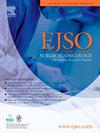Prognostic role of postoperative persistence of ctDNA molecular signature after liver resection for colorectal liver metastases: Preliminary results from a prospective study
IF 3.5
2区 医学
Q2 ONCOLOGY
引用次数: 0
Abstract
Introduction
Liver resection represents the cornerstone treatment for Colo-Rectal Liver Metastases (CRLM), but it is still followed by a high recurrence rate. The identification of a valid and reproducible predictor of recurrence can play a key role in correct and timely management of the disease. In this scenario, liquid biopsy may represent an integrative, less invasive, and easily manageable tool to clinically stratify colorectal cancer patients.We aimed to investigate the prognostic role of persistent circulating tumor DNA (ctDNA) signature on CRLM recurrence after liver resection.
Methods
A series of 51 consecutive patients undergoing liver resection for CRLM were prospectively enrolled between January 2020 and March 2023. Patients underwent liquid biopsy from peripheral blood samples before and after surgery. Other risk factors for disease recurrence were also investigated.
Results
Twenty-nine patients were found to be positive for one of the clinically relevant molecular alterations detected by NGS, at preoperative (T0) ctDNA analysis. At univariate analysis, total tumor size bigger than 60 mm (p = 0.046, HR 2.486) and postoperative persistence of ctDNA molecular signature (p = 0.024, HR 2.831) were significantly associated with recurrence. Multivariable Cox Regression analysis showed that only postoperative persistence of ctDNA molecular signature was associated with recurrence (p = 0.027, HR 2.766). Similarly, 1–3 yr DFS was significantly lower in the subgroup with persistence of molecular signature at liquid biopsy (100–49.5 % vs 57.1–21.4 %, p = 0.018).
Conclusion
Postoperative persistence of ctDNA molecular signature could represent a useful tool to predict recurrence after liver resection for CRLM patients.
求助全文
约1分钟内获得全文
求助全文
来源期刊

Ejso
医学-外科
CiteScore
6.40
自引率
2.60%
发文量
1148
审稿时长
41 days
期刊介绍:
JSO - European Journal of Surgical Oncology ("the Journal of Cancer Surgery") is the Official Journal of the European Society of Surgical Oncology and BASO ~ the Association for Cancer Surgery.
The EJSO aims to advance surgical oncology research and practice through the publication of original research articles, review articles, editorials, debates and correspondence.
 求助内容:
求助内容: 应助结果提醒方式:
应助结果提醒方式:


